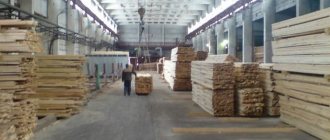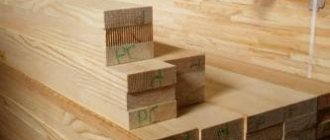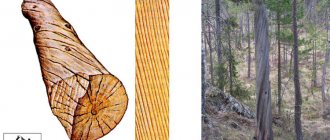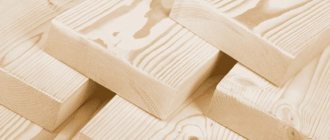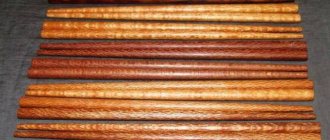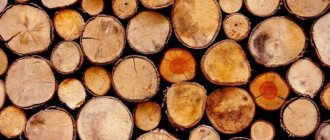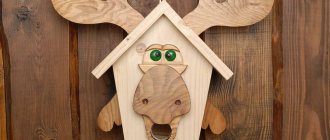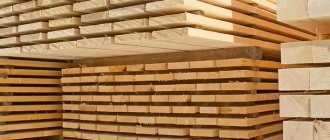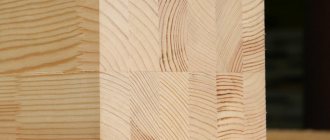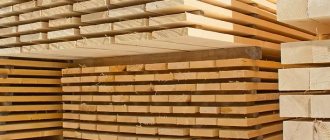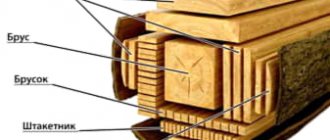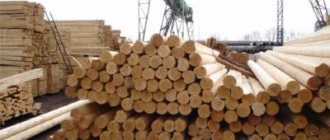It will be useful to know the range and standards of softwood lumber (as well as hardwood) when carrying out thorough, capital private construction, as well as when carrying out various types of buildings on your own, without the involvement of expensive teams. All parameters and nominal sizes, in principle, are described in GOSTs - nothing complicated to figure out on your own. And the product of any sawmill, in the form of a variety of wood materials, is ultimately guided by these generally accepted standards of length and thickness with width.
Possible types of products for sawmills
Any of the above edged softwood lumber according to its characteristics corresponds to a certain margin of durability in operation, strength, and efficiency when used on construction sites
But in order to bring these indicators “to a common denominator”, regulatory documents determine the lowest values of these technical characteristics. All this is the determining factor, for example, for drawing up contracts or for regulating relationships between consumers and suppliers of relevant products.
Wood quality
Deciduous wood is divided into 4 grades. Coniferous edged lumber - 5 (plus - selected). The best variety is recognized as selected and is designated “O” or a horizontal stripe. The rest of the quality range is indicated by numbers or the corresponding number of strips. It is typical that a particular piece of lumber is assessed by the worst of the cut sides or edges. And grades are determined due to the absence or presence of cracks, chips, deformations, knots, possible rot and moisture. The type of sawn wood also depends on the precision of processing.
Typically, first grade lumber can be used for a variety of building structures - permanent and temporary. And also for the final finishing of walls and floors of standard thickness. Second-grade lumber is suitable for the construction of decking, formwork, and sheathing. Third-class - for load-bearing structures of the third category. But the fourth grade is used for the manufacture of small pieces or for containers. It is characteristic that the moisture parameter for the latter variety is not standardized. But for the previous ones, the humidity parameter should not be higher than 22 percent. When it exceeds, the material is called “raw”. At the same time, it significantly loses its strength.
Defects of lumber from the inside
Types of timber
Technical characteristics of vinyl siding
The trunks of deciduous or coniferous trees, with branches and knots removed and sawn across, are round lumber. The bark on them can be removed. The thickness varies. Also, their purpose may be different. There are 4 groups of round timber.
- Materials for peeling and planing.
- Materials for sawing.
- Materials for processing and producing wood pulp and cellulose.
- Materials for use without sawing, i.e. in round form.
The production of round timber is carried out with the aim of obtaining lumber. Softwood roundwood is primarily a raw material for lumber production.
Softwood lumber
GOST 8486-57 determines the nominal dimensions for softwood lumber. Bars and boards are available from a meter to 6.5 meters in length (gradation - 0.25 meters). Materials over 6.5 meters in length are also produced on special orders. The length tolerance is set at 25 and 50 millimeters.
Softwood lumber
Coniferous lumber is divided into the following varieties:
- selective,
- 1, 3, 3, 4, 5.
- bars - from one to five. Selected varieties - not produced.
Table how many boards are in 1 cube (pieces/meters)
Board dimensions Volume of the 1st board Boards in one cube (pieces) 25x100x60000.015 m366.6 pcs 25x130x60000.019 m351.2 pcs 25x150x60000.022 m344.4 pcs 25x200x60000.030 m333.3 pcs 30x20 0x60000.036 m327.7 pcs.40x100x60000.024 m341.6 pcs.40x200x60000, 048 m320.8 pcs40x150x60000.036 m327.7 pcs50x100x60000.030 m333.3 pcs50x150x60000.045 m322.2 pcs50x200x60000.060 m316.6 pcs
According to GOST, the length of an edged board is 6 m. Taking into account the individual characteristics of a construction project, the consumer can order a different size, but this must be consistent with the standards of transportation, storage, installation and operation of the finished object.
The thickness of a standard edged board is usually 25, 40 or 50 mm.
with a thickness of 100 – 150 mm. The length, as stated above, is 6 meters. Small bars come in 40 x 40 mm and 50 x 50 mm.
with a length of 3 or 6 meters. The cost of an edged board depends on what category of lumber the timber belongs to: standard or non-standard. The final cost of edged boards is determined taking into account the quality of the resulting material and its performance qualities.
To ensure the proper quality of finished products, it is necessary to comply with the rules of storage and transportation.
In particular, when storing edged boards, one must take into account its ability to absorb moisture from the ground. Therefore, the material must be placed on pallets and transfer intermediate bars must be used. In this form, the boards will be better ventilated, maintain the maximum level of humidity and dry out slightly.
The main materials used for the production of edged boards are: aspen, fir, larch, pine and cedar. Mahogany, ash, oak, linden and other types of wood are used for interior decoration of buildings. It should be noted that the cost of these materials exceeds similar products made from other types of trees, but in terms of aesthetic and performance characteristics they are superior to other types of wood.
In practice, there are often cases when, as a result of improper storage, the quality of the board suffered, and the product was transferred to a lower grade category. In this case, commodity experts of trading organizations must re-evaluate the goods and, taking into account the existing defects, assign the appropriate grade and price. The marking label must contain a mark indicating the markdown has been carried out.
home⇒ construction mat⇒ finishing
Each type of lumber has its own model range and standard sizes.
Main regulatory documents: GOST 2695-83: for hardwood boards, and GOST 24454-80: for softwood boards.
Edged boards, flooring and lining:
width: from 64 (mm) to 275 (mm);
thickness: from 16 (mm) to 75 (mm); length: from 1000 (mm) to 6000 (mm) with gradation of 250 (mm).
Bars and bars:
width: from 40 (mm) to 275 (mm);
thickness: from 40 (mm) to 275 (mm); length: from 1000 (mm) to 6000 (mm) with gradation of 250 (mm).
Rail (standard sizes):
25 (mm)x 50 (mm);
25 (mm) x 40 (mm); 20 (mm) x 40 (mm); 22 (mm) x 50 (mm). Parameters of the main types of lumber Drawing Drawing and parameters of a typical model Length (mm) Total length of the board in (mm) Width (mm) Overall width of a typical model in (mm) Thickness (mm) Board thickness in (mm) Board (go) from 1000 (mm) to 6000 (mm) 75 (mm) 100 (mm) 125 (mm) 150 (mm) )175 (mm)200 (mm)225 (mm)250 (mm)275 (mm)16 (mm)19 (mm)22 (mm)25 (mm)32 (mm)40 (mm)50 (mm)60 (mm) 75 (mm) Timber (go) up to 6000 (mm) from 70 (mm) to 270 (mm) from 145 (mm) to 279 (mm) Lining (go) from 1200 (mm) to 5700 (mm) 95 (mm)95 (mm)140 (mm)15 (mm)12 (mm)12 (mm)Rack (go) from 500 (mm) to 3000 (mm)22 (mm)20 (mm)25 (mm) 40 (mm) 50 (mm) Picket fence (go) from 500 (mm) to 1800 (mm) from 40 (mm) to 100 (mm) from 16 (mm) to 40 (mm) Skirting board (go) from 1000 (mm ) up to 2000 (mm) from 15 (mm) to 60 (mm) from 40 (mm) to 80 (mm) Bead (go) from 1000 (mm) to 2000 (mm) 8 (mm) 10 (mm) 10 ( mm) Block house (go) from 2000 (mm) to 6000 (mm) from 00 (mm) to 230 (mm) from 20 (mm) to 40 (mm) Rafters (go) from 3000 (mm) to 5000 ( mm) from 160 (mm) to 220 (mm) from 20 (mm) to 80 (mm) Sleepers (go) I 180 (mm) II 160 (mm) II 150 (mm) 2750 (mm) 2750 (mm) 2750 (mm)250 (mm)230 (mm)230 (mm)
The dimensions of lumber are established by state standards. The parameters of semi-finished products are calculated based on the scope of their application for the needs of the domestic market and export of products.
Deciduous
GOST 2695-56 is decisive for deciduous lumber. Traditionally, they are made from beech and ash wood, oak and birch, maple and alder, and some other types of deciduous trees (both soft and hard).
Hardwood lumber
Deciduous trees are divided into 4 varieties. In this case, the “humidity” parameter of the supplied materials should not exceed 25 percent. The size of lumber according to the “length” parameter is set from one to 6.5 meters (gradation – 0.1 meter). Width – from 50 millimeters (gradation – 10 millimeters). Nominal dimensions for beams min. 130x130 millimeters max. 220x220 millimeters (on request - 250x250).
For construction and sawing, hardwood timber is used, at least two meters long, and coniferous timber, 4-6.5 meters long. For more information, see the tables below and excerpts from GOST.
Table 1
The generally accepted nominal dimensions of lumber, given in millimeters (thickness/width)
Table 2
Cross sections (excerpt from GOST)
Table 3
Permissible deviations in millimeters (excerpt from GOST)
Table 4
The standard is given in accordance with CMEA No. 1264-78, CMEA No. 1265-78, No. 1147-78, CMEA No. 1266-78
Features of the assortment
The range represents all the diversity of wood characteristics. Taking into account all the nomenclature requirements of the assortment, wood is divided into the following building elements:
Types of boards
- Plates are two equal parts of a log sawn in half.
- Quarters are four equal parts of the log being cut.
- A block is an element in which the width does not exceed two thicknesses.
- A sleeper is a product with a large width, thickness, and short length.
- Croaker is the side part of a log, where one side is flat and the other is semicircular.
A wide variety of different products are made from wood. All of them are regulated by departmental GOSTs. The article shows the main directions for choosing the assortment required for the construction of private houses, country cottages, dachas, garages, and other buildings. Detailed characteristics of lumber can be found in special tables.
Materials
But the classification by variety is incomplete - it is still necessary to understand what is the difference between coniferous and deciduous species, and also which ones are better. Coniferous wood usually has straight trunks and is of decent quality. It is relatively easy to process. However, such “gifts of the forest” can be distinguished by their high strength. From them you can safely build even load-bearing structures of one-story and two-story houses.
Pine is very popular. It has relatively low moisture absorption. Larch has a greater absorption capacity, but upon contact with water it becomes harder. In favor of deciduous lumber (aspen, linden, birch, poplar) they say:
- fairly high density;
- grace of texture;
- Quite a long service life.
Kinds
The name of timber in the classifier and other documents depends on the possibilities of their further use:
- the trunk after removing the roots and branches is usually called a tree whip;
- the process of dividing a trunk into fragments is called “bucking”, and these fragments themselves are called ridges;
- depending on the cross-section, the ridges are additionally divided into subtovarnik, log and pole (their sizes are respectively: 80-110, from 120 or more, 30-70 mm).
Unprocessed timber is the same tree that has been cut down, cleaned and cut into pieces. It is also common to call them round timber, round timber or round timber. Such products are in demand by match factories, pulp and paper mills, and plywood manufacturers.
Processed timber is divided into:
- lumber;
- chipped products;
- wood veneer;
- some other products.
Sawn timber is produced by further longitudinal division of logs. They are further divided into general and special categories. The first category includes, for example, lumber used for the construction of wooden structures (fences, private houses), as well as for the production of ready-made building blocks. The second group includes things that can withstand the highest possible loads and severe tests (for example, blanks for musical instruments, parts of carriages and aircraft).
According to the type of diameter, lumber is divided into the following products:
- beam;
- board;
- lagging;
- sleeper;
- bar.
1st grade
The issue of assortment is closely related to the quality characteristics of the finished product
Important: even if the timber is marked with a certain varietal group, the batch may contain individual inclusions (up to 10%) of both higher and lower quality products. When each beam or board is shipped, no one examines it “under a microscope”
That is why personal incoming control of incoming goods is so important.
Before moving on to a further description of the varieties, it should be noted that all products are divided into business and firewood categories. They are used respectively for construction and subsequent processing. All this information is very important for a deeper understanding of what each variety is and what their main characteristics are.
First-class wood is a high-quality and widespread product. It may contain only a limited number of knots and other defects.
2nd grade
This includes products that contain minor deviations from grade 1 standards that do not negatively affect the visual characteristics of the surface. There cannot be a single deepened crack, not a single rotten knot. Tobacco knots, of course, are also prohibited. But loose knots are acceptable. This material is used mainly for shields.
3rd grade
This is already considered low quality wood. However, cheapness still determines a stable demand for it. This material is commonly used in the packaging industry
Important: despite the bad reputation, this includes products that meet the requirements of the standards. Large intergrown knots and cracks extending to the full depth and affecting the end should not be allowed
4th grade
It is the lowest of the officially permitted categories. There may be any imperfections and deviations. It is allowed to include even trimmings from any higher quality timber here. This type of wood is used to make:
- pallets;
- handles for utility construction tools;
- temporary forests;
- formwork;
- secondary sheds.
